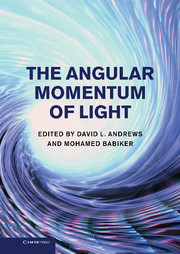Book contents
- Frontmatter
- Contents
- List of contributors
- Preface
- 1 Light beams carrying orbital angular momentum
- 2 Vortex transformations and vortex dynamics in optical fields
- 3 Vector beams in free space
- 4 Optical beams with orbital angular momentum in nonlinear media
- 5 Ray optics, wave optics and quantum mechanics
- 6 Quantum formulation of angle and orbital angular momentum
- 7 Dynamical rotational frequency shift
- 8 Spin-orbit interactions of light in isotropic media
- 9 Quantum electrodynamics, angular momentum and chirality
- 10 Trapping of charged particles by Bessel beams
- 11 Theory of atoms in twisted light
- 12 An experimentalist's introduction to orbital angular momentum for quantum optics
- 13 Measurement of light's orbital angular momentum
- 14 Efficient generation of optical twisters using helico-conical beams
- 15 Self-similar modes of coherent diffusion with orbital angular momentum
- 16 Quantum entanglement of orbital angular momentum
- Index
- References
7 - Dynamical rotational frequency shift
Published online by Cambridge University Press: 05 December 2012
- Frontmatter
- Contents
- List of contributors
- Preface
- 1 Light beams carrying orbital angular momentum
- 2 Vortex transformations and vortex dynamics in optical fields
- 3 Vector beams in free space
- 4 Optical beams with orbital angular momentum in nonlinear media
- 5 Ray optics, wave optics and quantum mechanics
- 6 Quantum formulation of angle and orbital angular momentum
- 7 Dynamical rotational frequency shift
- 8 Spin-orbit interactions of light in isotropic media
- 9 Quantum electrodynamics, angular momentum and chirality
- 10 Trapping of charged particles by Bessel beams
- 11 Theory of atoms in twisted light
- 12 An experimentalist's introduction to orbital angular momentum for quantum optics
- 13 Measurement of light's orbital angular momentum
- 14 Efficient generation of optical twisters using helico-conical beams
- 15 Self-similar modes of coherent diffusion with orbital angular momentum
- 16 Quantum entanglement of orbital angular momentum
- Index
- References
Summary
Introduction
The term rotational frequency shift (RFS) has been used in different contexts and given different meanings [1]-[8]. Other terms have also been used (e.g. azimuthal Doppler shift, angular Doppler shift) to describe various related phenomena. In this article we stick to the meaning of the rotational frequency shift given by us in [9]. In order to make a clear distinction between our RFS and other related shifts we use the term dynamical RFS (DRFS). We will study the spectral properties of radiation emitted by rotating quantum sources.
Radiation emitted by sources in motion looks different when observed in the laboratory frame. Frequency shift can only be determined for monochromatic waves. In general, a monochromatic field will lose this property when observed from a moving frame. Therefore, to observe a frequency shift we have to restrict ourselves to some special forms of radiation, which fully preserve their monochromaticity when the frame of reference is changed.
When the source moves with constant velocity, one observes the well-known Doppler shift. In this case a special role is played by plane waves characterized by their wave vectors. We may invoke the relativistic transformation properties of a wave vector to derive the change of frequency. As a result, all inertial observers see such waves as monochromatic plane waves with a shifted frequency and a transformed direction of propagation. This effect can also be deduced from the transformation laws of the photon energy-momentum four-vector pμ = ℏkμ. For uniform motion this kinematical Doppler shift is the only effect.
- Type
- Chapter
- Information
- The Angular Momentum of Light , pp. 162 - 173Publisher: Cambridge University PressPrint publication year: 2012
References
- 1
- Cited by

